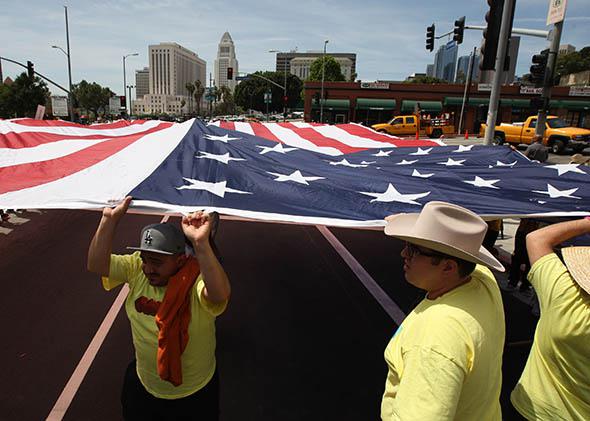Between 2000 and 2010, Hispanics grew from 12.5 percent of the American population to 16.3 percent, a change of more than 30 percent. The Great Recession slowed migration from Mexico and other Spanish-speaking countries, but researchers still project a steady increase in the number of Hispanic residents. By 2050, predicts the Census Bureau, Hispanics will grow to 28 percent of the population, the largest portion of a “majority-minority” America that includes blacks, Asians, Pacific Islanders, and mixed-race people.
The projection is sound, but—as I wrote last month—we should temper this prediction of a majority-minority future with an awareness of race and shifting identity. As a category, “Hispanic” includes a range of ethnic and racial backgrounds, from Afro-Brazilians and brown-skinned Puerto Ricans to indigenous Mexicans and Argentinians of largely European descent.
Assimilation, intermarriage, and upward mobility might lead some Hispanics to identify as “white,” even as they hold to their cultural heritage. And in the same way, society may reciprocate, treating light-skinned, European Hispanics as ethnic whites, akin to Italians and Eastern Europeans. Which would fit the American pattern.
One hundred years ago, Italians were considered a separate race of people, distinct from Anglo-Americans in the nation’s racial taxonomy. And fear of their presence sparked violence, discrimination, and strict anti-immigration laws. With time, mobility, and the shared experience of depression and war, however, those Italians began to see themselves as white and mainstream, and in turn, white Americans agreed.
In fact, new research says that’s happening right now. According to data presented at an annual meeting of the Population Association of America, an estimated 1.2 million Americans changed their racial and ethnic identification from “Hispanic, Latino or Spanish origin” on the 2000 census to “white” on the one in 2010. Here’s the Pew Research Center with more:
The largest number of those who changed their race/ethnicity category were 2.5 million Americans who said they were Hispanic and “some other race” in 2000, but a decade later, told the census they were Hispanic and white, preliminary data showed. Another 1.3 million people made the switch in the other direction. Other large groups of category-changers were more than a million Americans who switched from non-Hispanic white to Hispanic white, or the other way around.
What’s interesting is that this happened during a decade of rising anti-immigrant sentiment, draconian anti-immigrant laws, and a rising pan-Latino identity, which seem to stand as countervailing forces.
To be clear, as Nate Cohn notes for the New York Times, “White identification is not necessarily a sign that Hispanics consider themselves white. Many or even most might identify their race as “Hispanic” if it were an explicit option.” At the same time, this change reflects growing assimilation among a group of Hispanics, who—as Cohn writes—“are likelier to be second- and third-generation Hispanics than foreign-born and noncitizen Hispanics” and have higher incomes and more education.
Intermarriage will of course play a role in shaping identity. Already, intermarriage is most common among whites and Hispanics. The children of those unions could see themselves as white and Hispanic, simply Hispanic, or simply white.
In any case, it’s more than clear that some Hispanics are following the path of previous European immigrant groups, where success breeds assimilation, and assimilation brings whiteness.
